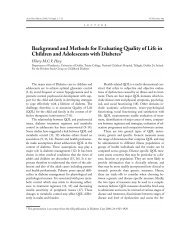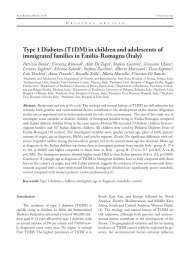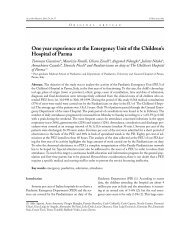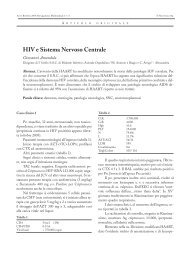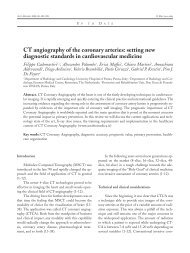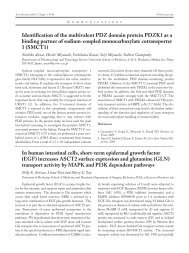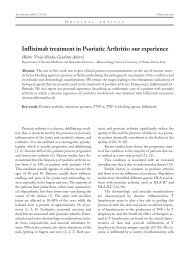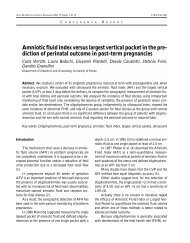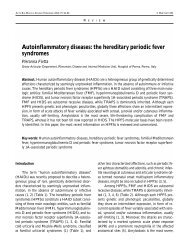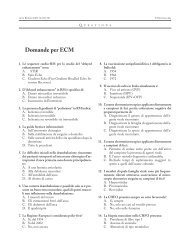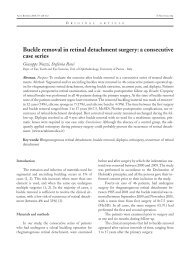Mattioli - Acta Bio Medica Atenei Parmensis
Mattioli - Acta Bio Medica Atenei Parmensis
Mattioli - Acta Bio Medica Atenei Parmensis
Create successful ePaper yourself
Turn your PDF publications into a flip-book with our unique Google optimized e-Paper software.
ACTA BIO MEDICA ATENEO PARMENSE 2004; 75; Suppl. 1: 59-61 © <strong>Mattioli</strong> 1885<br />
C O N F E R E N C E R E P O R T<br />
Amnioscopy: Is it actual<br />
Stefano Raboni, Christine T. Kaihura, Stefania Fieni<br />
Department of Gynecology, Obstetrics and Neonatology, University of Parma, Parma, Italy<br />
Abstract. Amnioscopy is an invasive exam employed to visualise the forebag of the amnionic sac and to look<br />
out for meconium staining. Even though recognition of strongly stained fluid is easy, interpretation of those<br />
cases that are thinly stained is more difficult, since in these cases which are more common to find there could<br />
be an initial staining. On the other hand, visualisation of the forebag does not necessarily depict the condition<br />
of the rest of the amniotic fluid, especially in those cases where the fetal head is engaged. Moreover ascertainment<br />
that the amniotic fluid is limpid, only holds a temporary significance since it cannot predict successive<br />
release of meconium. The incidence of meconium stained fluid prior to labour has been found to<br />
range between 6-11%. Amnioscopy hence seems to hold a historical interest, and should only be employed<br />
in pregnancies at term where the cervix is sufficiently dilated to permit introduction of the amnioscope. Correlation<br />
between finding of meconium stained fluid during labour (1.5-18 % reaching 44 % in post-term<br />
pregnancies) with alterations at cardiotocography and above all to fetal acidosis or low Apgar scores at birth<br />
still remains controversial. Passage of meconium does not seem to express fetal compromise, at least until<br />
other parameters (CTG) do not support this suspicion. Finally it is important to remember that amnioscopy<br />
could in some cases lead to serious infections with chorioamnionites occasionally leading to fetal death. Accidental<br />
rupture of the membranes could also occur, reported in 1.4 % of the cases, harmful especially when<br />
far from labour. From these considerations, and since majority of the cases especially with chronic fetal distress,<br />
release of meconium is preceded or accompanied by reduction in the amniotic fluid quantities, the last<br />
identifiable through ultrasound. We agree with those authors who advise its use only when adequate management<br />
through CTG and ultrasound is not possible, and anyhow only in pregnancies at term.<br />
Key words: Amnioscopy, amniotic fluid, perinatal outcome<br />
Introduction<br />
Amnioscopy is an invasive exam employed to visualise<br />
the forebag of the amnionic sac to look out for<br />
meconium staining. The concept of finding meconium<br />
stained fluid being correlated to increased risk of<br />
fetal distress and perinatal mortality has been consolidated<br />
(table 1).<br />
Ideally, amnioscopy should serve both to verify<br />
presence of fluid with its amount and verify its quality<br />
(whether limpid or in its various degrees of meconium<br />
staining).<br />
It is now of common knowledge that amnioscopy<br />
is unuseful for the first case, since only the lower part<br />
(forebag), of the amnionic sac, not indicative of the remaining<br />
portion is observed. Furthermore this is easily<br />
evaluated using ultrasound where amniotic pockets<br />
are measured. Visualisation of the membrane moreover<br />
does not exclude rupture of membranes.<br />
The second aim is that of evaluating the quality<br />
of the amniotic fluid. Even though recognition of<br />
strongly stained fluid is easy, the most frequent and<br />
not less relevant number of cases that contain minor<br />
quantities of meconium, probably expressing an initial
60 S. Raboni, C.T. Kaihura, S. Fieni<br />
Table 1<br />
Classification Prognostic significance Perinatal mortality<br />
Limpid: limpid and in normal quantities Fetal-well-being 2/1000<br />
Grade 1 Meconium: light meconium staining, with amniotic Possible fetal compromise 2/1000<br />
fluid in normal quantities<br />
Grade 2 Meconium staining: thickly stained of meconium, Possible fetal compromise 11/1000<br />
reduced volume of the amniotic fluid<br />
Grade 3 Meconium staining: pea-soup meconium Pathological 11/1000<br />
Absen : amniotic fluid not evaluatable Possible fetal compromise 11/1000<br />
(to be considered as in grade 2)<br />
colouring are more difficult to interpret. On the other<br />
hand, the forebag does not necessarily express the condition<br />
of the remaining portion, especially when the<br />
fetal head is engaged. Furthermore observation of limpid<br />
liquid is only of temporary importance since it<br />
cannot predict successive and possible releases of meconium.<br />
Three degrees of staining can be distinguished, as<br />
reported in literature (table 1): thinly stained liquid,<br />
thickly stained fluid, pea-soup meconium. This distinction<br />
is fundamental since for the first case no relevant<br />
clinical implications in terms of fetal compromise<br />
have been observed.<br />
For the second degree, intensive fetal surveillance<br />
needs to be carried out, to assure immediate delivery<br />
eventually through Caesarean section, on appearance<br />
of alterations on cardiotocography if spontaneous<br />
delivery is not imminent. The third degree<br />
should always induce immediate delivery, eventually<br />
through Caesarean section unless spontaneous delivery<br />
is imminent (2). The question that therefore<br />
needs to be made is, when is it useful to know the<br />
quality of the fluid Knowing that the incidence of<br />
meconium stained fluid is 6-11% according to<br />
Woods (3), amnioscopy holds a historical interest<br />
and should be used in pregnancies at term, in those<br />
patients with a sufficiently dilated cervix, that allow<br />
introduction of the amnioscope. The same author also<br />
emphasises, the controversial and yet to be demonstrated<br />
correlation between finding of meconium<br />
stained fluid (1.5-18 % reaching 44 % in pregnancies<br />
at term) with alterations at cardiotocography and<br />
above all to fetal acidosis and low apgar scores at<br />
birth. Meconium alone does not seem to indicate fetal<br />
distress, atleast until other parameters do not support<br />
this suspicion.<br />
The second query is, if finding of meconium staining<br />
especially of grade III, is not really associated to<br />
increased fetal distress, then why does it in all cases<br />
necessitate immediate delivery by Caesarean section<br />
The answer comes from observation of a 5-7 times increase<br />
in neonatal mortality associated to finding of<br />
thickly stained amniotic fluid, although not observed<br />
for intrauterine fetal death. The cause of this dramatic<br />
event is only attributable to aspiration of the amniotic<br />
fluid, frequent among the more compromised newborns,<br />
and occurs during labour. This led to the erroneous<br />
belief that meconium was responsible for this<br />
pathology and for fetal distress, which instead has only<br />
been found to have an increased incidence when alterations<br />
on cardiotocography were observed.<br />
The third query is: Is amnioscopy harmful or is it<br />
always innocuous Does it lack complications, and<br />
therefore always feasible Experience has shown (4)<br />
that amnioscopy can at times cause serious infections<br />
with chorionamnionitis which occasionally leads to<br />
fetal death. Moreover in 1.4% of the cases (5) it can<br />
accidentally cause rupture of membranes, which could<br />
be dangerous especially when far from labour.<br />
From these considerations therefore, and considering<br />
that majority of the cases and especially those<br />
with chronic fetal distress, passage of meconium, is<br />
usually preceded or accompanied by reduction in the<br />
amniotic fluid quantities, identifiable through ultrasound,<br />
we agree with those authors who advise use of<br />
this exam only where monitoring using ultrasound<br />
and cardiotocography is not possible and anyway in<br />
pregnancies at term.
Amnioscopy: is it actual<br />
61<br />
Reference<br />
1. Valle A, Bottino S, Meregalli V, Zanini A. Manuale di Sala<br />
Parto. Edi-ermes-Milano, 1992.<br />
2. Manning, Fetal Medicine, Principle and Practice. 1998: 191.<br />
3. Maternal Fetal Medicine, Creasy and Resnik, 1994: 417.<br />
4. Pescetto G, De Cecco L, Pecorari D, Ragni N. Ginecologia<br />
ed Ostetricia. Società Editrice Universo- Roma. Edizione<br />
2001: 1279.<br />
5. Lee KH. Supervision of high risk cases by amnioscopy. Am J<br />
Obstet Ginecol 1972; 112 (1): 46-9.<br />
Correspondence: Stefano Raboni<br />
Department of Obstetrics and Gynecology<br />
University Hospital<br />
Via Gramsci, 14<br />
43100 Parma, Italy<br />
Tel: +39/0521/702436<br />
Fax: +39/0521/290508<br />
E-mail: stefano.raboni@unipr.it



